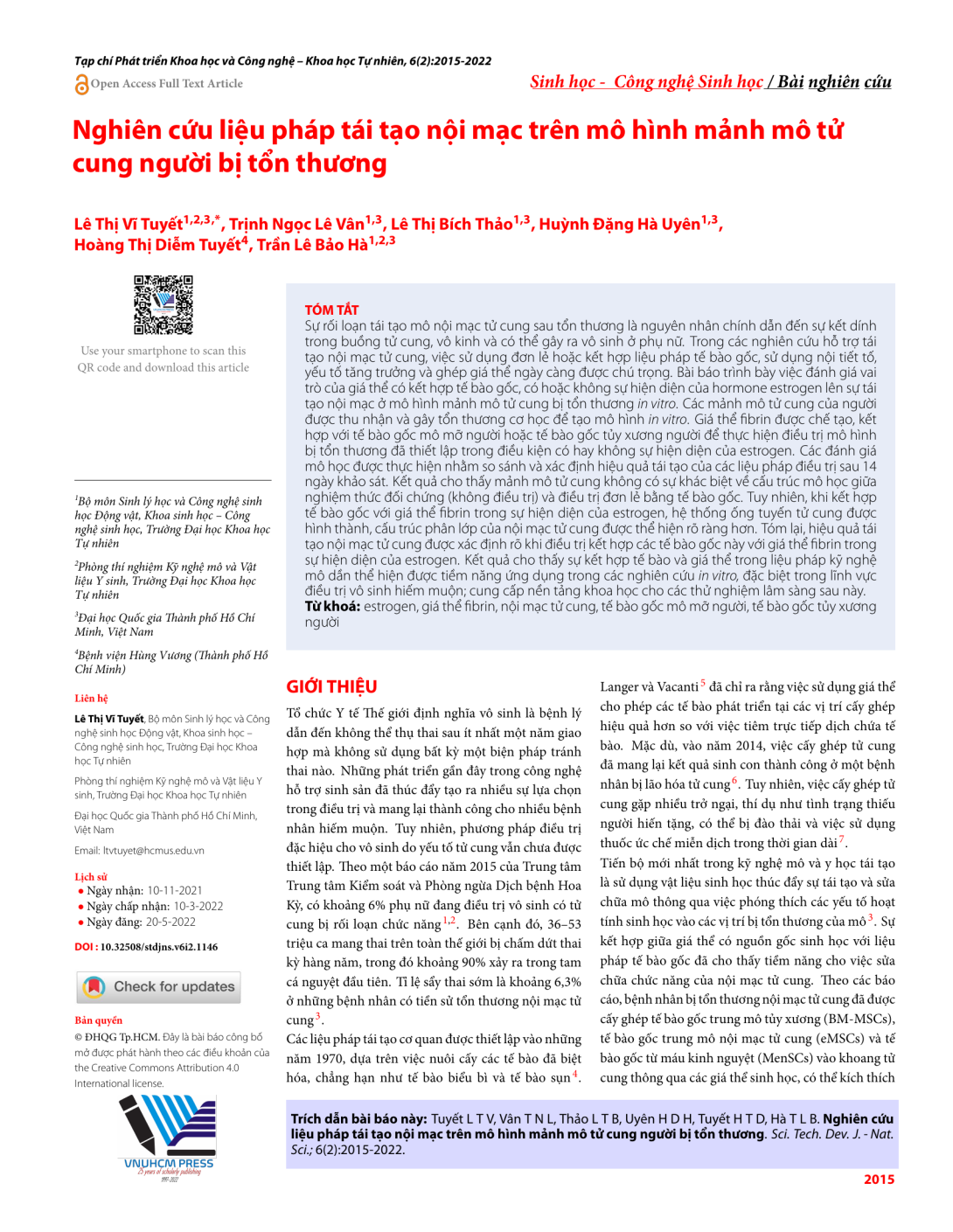
Sự rối loạn tái tạo mô nội mạc tử cung sau tổn thương là nguyên nhân chính dẫn đến sự kết dính trong buồng tử cung, vô kinh và có thể gây ra vô sinh ở phụ nữ. Trong các nghiên cứu hỗ trợ tái tạo nội mạc tử cung, việc sử dụng đơn lẻ hoặc kết hợp liệu pháp tế bào gốc, sử dụng nội tiết tố, yếu tố tăng trưởng và ghép giá thể ngày càng được chú trọng. Bài báo trình bày việc đánh giá vai trò của giá thể có kết hợp tế bào gốc, có hoặc không sự hiện diện của hormone estrogen lên sự tái tạo nội mạc ở mô hình mảnh mô tử cung bị tổn thương in vitro. Các mảnh mô tử cung của người được thu nhận và gây tổn thương cơ học để tạo mô hình in vitro. Giá thể fibrin được chế tạo, kết hợp với tế bào gốc mô mỡ người hoặc tế bào gốc tủy xương người để thực hiện điều trị mô hình bị tổn thương đã thiết lập trong điều kiện có hay không sự hiện diện của estrogen. Các đánh giá mô học được thực hiện nhằm so sánh và xác định hiệu quả tái tạo của các liệu pháp điều trị sau 14 ngày khảo sát. Kết quả cho thấy mảnh mô tử cung không có sự khác biệt về cấu trúc mô học giữa nghiệm thức đối chứng (không điều trị) và điều trị đơn lẻ bằng tế bào gốc. Tuy nhiên, khi kết hợp tế bào gốc với giá thể fibrin trong sự hiện diện của estrogen, hệ thống ống tuyến tử cung được hình thành, cấu trúc phân lớp của nội mạc tử cung được thể hiện rõ ràng hơn. Tóm lại, hiệu quả tái tạo nội mạc tử cung được xác định rõ khi điều trị kết hợp các tế bào gốc này với giá thể fibrin trong sự hiện diện của estrogen. Kết quả cho thấy sự kết hợp tế bào và giá thể trong liệu pháp kỹ nghệ mô dần thể hiện được tiềm năng ứng dụng trong các nghiên cứu in vitro, đặc biệt trong lĩnh vực điều trị vô sinh hiếm muộn; cung cấp nền tảng khoa học cho các thử nghiệm lâm sàng sau này.
The disorder of endometrial tissue regeneration is the main cause of uterine adhesions, amenorrhea, and infertility in women. Monthly changes in the endometrial cycle and injured uterine regeneration confirm the role of stem cells, hormonal regulation as well as endometrial tissue structure. In previous studies, the use of a single or combined stem cell therapy, hormone therapy, and scaffold transplantation had been increasingly emphasized. This paper presented the evaluatation of the role of the stem cell and matrix combination in the presence of estrogen hormone in endometrial regeneration on the human injured uterine tissue model. Human uterine tissue fragments were collected and mechanically damaged for in vitro modeling. The fibrin scaffolds were fabricated and combined with, respectively, human adipose tissue stem cells (hADSCs) and human bone marrow stem cells (hBMSCs) to be treated in an established injured model in conditions with or without estrogen. Histological assessments were performed to compare and confirm the regenerative effect of the treatments after 14 days of investigation. The results showed that there was no difference in the histological structure between the control treatment (no treatment) and the single treatment with stem cells. However, when stem cells were combined with fibrin matrix in the presence of estrogen, the uterine glands were formed where the layered structure of the endometrium was clearly demonstrated. In conclusion, the endometrial regenerating effect was well established by the combined treatment of these stem cells with fibrin scaffolds in the presence of estrogen. The combination of cells and scaffolds in tissue engineering therapy gradually showed the potential applications for in vitro studies, especially in the field of infertility treatment.
- Đăng nhập để gửi ý kiến
